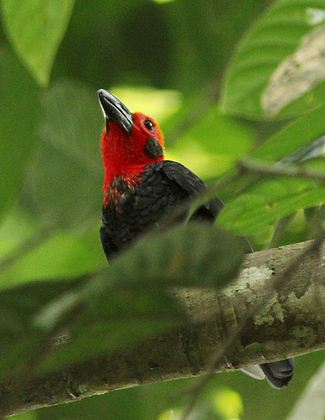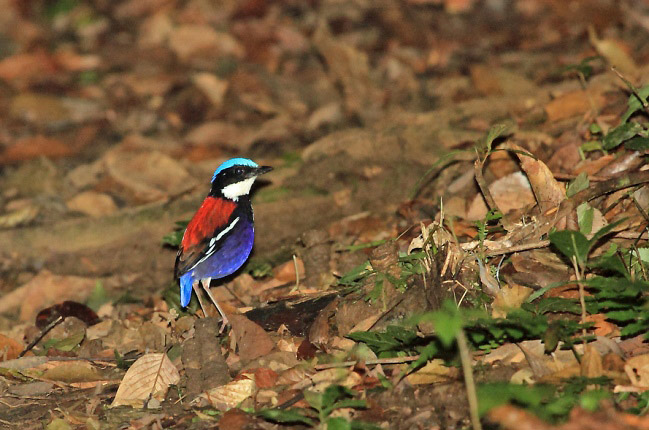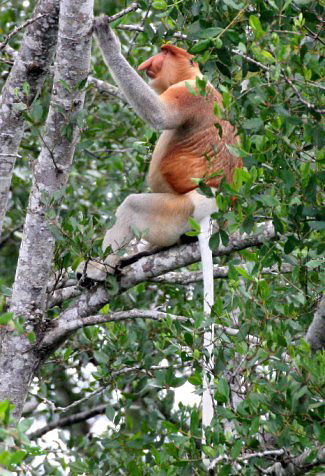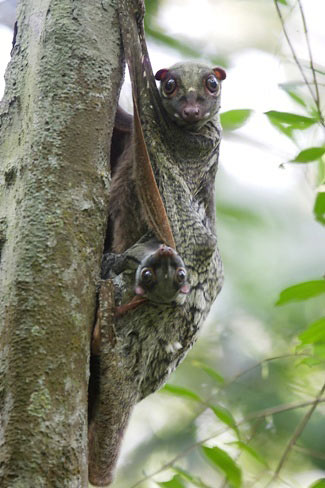

The unique endemic Bornean Bristlehead at Sepilok by David Beadle.
- Over 60 endemic birds including such spectacular species as Whitehead’s Trogon, Blue-banded and Blue-headed Pittas, Whitehead’s Broadbill, Bornean Bristlehead, Bornean Green Magpie, Black-throated, Mountain and Bornean Wren-babblers, Fruithunter, White-crowned Shama and Whitehead’s Spiderhunter
- With a chance of Bornean Ground-cuckoo and Hose's Broadbill
- And other spectacular localized birds such as Great Argus, Storm's Stork, Giant Pitta and Temminck's Sunbird
- As well as a long list of classic fabulous South East Asian birds including trogons, kingfishers, bee-eaters, broadbills,
hornbills,
leafbirds and babblers - Then there are the mammals, such as Orang-utan, Proboscis Monkey, Bornean Gibbon, Western Tarsier, Red Giant Flying Squirrel and a chance of Colugo
- Many amazing insects including Lantern Bugs, Rhinoceros Beetles, Atlas Moths and birdwing butterflies
- And an extraordinary flora which includes orchids, pitcher plants and Rafflesia, the largest flowering plant in the world
- All in some of the oldest, tallest and richest rainforest on Earth, and surrounded by some of the best coral reefs in the world
- There are not many wild Orang-utans left. They occur only on the islands of Sumatra and Borneo, where numbers have been much reduced by massive forest clearances, especially for timber and to make way for palm plantations, the oil of which is an ingredient in numerous household products. A few of the many displaced Orang-utans are taken to Sepilok Rehabilitation Centre where they are semi-wild and easy to see – some visit the centre twice a day for food - but to find a fully wild Orang-utan is much harder. The three main places where there is a good chance are Gunung Leuser National Park in Sumatra, Tanjung Puting National Park in Kalimantan, southern Borneo, and Danum Valley in northern Borneo, easily the most accessible. Danum is a fantastic place, without doubt one of the top wildlife destinations in Asia and the world, thanks not only to the relatively high numbers of Orang-utans but also because of the presence of many other mammals and many spectacular birds in what is reputed to be the tallest lowland rain forest on Earth. From the airstrip outside the small town of Lahad Datu it is a three-hour drive to the comfortable Borneo Rainforest Lodge which is in a lovely setting above the Danum River. From the lodge visitors can walk straight into the magnificent forest or to the amazing canopy walkway a kilometre away. There are even night-drives and night-walks to look for nocturnal mammals such as the tiny Western Tarsier, but foremost in the majority of visitors minds are Orang-utans, the movements of which are monitored by the wardens who try to locate their nests – they may make a new nest every night - and then keep track of the individuals as they wander widely in search of leaves and fruit throughout the day.
- The diversity of wildlife at Danum Valley is astonishing but the numbers of individual species are low and they inhabit luxuriant lowland rain forest where they are very difficult to find, so in order to stand a chance of seeing a wide variety of wildlife here patience and persistence are two essential attributes to have during a stay of at least a few days, preferably a week, two if possible.

The proverbial 'jewel in the rainforest', the Blue-headed Pitta, captured here by Nigel Voaden, is one of Danum Valley's specialities.
- Sabah, North Borneo, can be covered pretty well in two weeks and some organized tours include the Malay Peninsula in their set itineraries or offer it as an extension. There, additional possibilities include Siamang and birds such as Rail-babbler, Malay Banded and Garnet Pittas, Orange-breasted and Red-headed Trogons, Fire-tufted Barbet, Long-tailed and Silver-breasted Broadbills, Sultan Tit, Blue Nuthatch, Himalayan Cutia and Silver-eared Mesia.
Best Birds and other wildlife in Sabah, Borneo
Birds
Borneo Endemics 64 - not all of these are possible in Sabah (Four partridges, two firebacks, four barbets, four pittas, two broadbills, Bristlehead, three wren-babblers and Fruithunter) Bornean (Red-breasted) Partridge, Sabah (Chestnut-necklaced) Partridge, Dulit Partridge, Crimson-headed Partridge, Bornean Peacock-pheasant, Bornean Crestless Fireback, Bornean Crested Fireback (also Bangka Island off southeast Sumatra), Bulwer’s Pheasant, Dulit Frogmouth (Kelabit Highlands, Sarawak), Bornean (Short-tailed) Frogmouth (Kelabit Highlands, Sarawak), Bornean (Cave) Swiftlet, Bornean Ground-cuckoo, Kinabalu (Mountain) Serpent-eagle, Whitehead’s Trogon, Black-faced (Banded) Kingfisher (also Bangka Island off southeast Sumatra), Bornean Brown Barbet, Bornean Barbet, Golden-naped Barbet, Mountain Barbet, White-fronted Falconet, Blue-banded Pitta, Black-crowned (Garnet) Pitta, Bornean Banded Pitta, Blue-headed Pitta, Hose’s Broadbill, Whitehead’s Broadbill, Black Oriole (Kelabit Highlands, Sarawak), Bornean Whistler, Bornean Bristlehead, Bornean Black Magpie, Bornean Treepie, Bornean Green Magpie, Friendly Grasshopper-warbler (Kinabalu Friendly (Bush) Warbler), Chestnut-vented (Ochraceous) Bulbul, Charlotte’s (Buff-vented) Bulbul, Green-winged Bulbul, Bornean (Black-capped) Bulbul, Pale-faced (Flavescent) Bulbul, Cream-eyed Bulbul, Bornean Stubtail, Chestnut-crested Yuhina, Pygmy White-eye, Mountain Black-eye, Grey-hooded (Chestnut-winged) Babbler, Black-throated Wren-babbler, Mountain Wren-babbler, Bornean Wren-babbler, Chestnut-hooded Laughingthrush, Bare-headed (Black) Laughingthrush, Everett’s Thrush, Fruithunter, White-crowned Shama, Bornean Blue-flycatcher, Eye-browed Jungle-flycatcher, Bornean Shortwing, Bornean (White-crowned) Forktail, Bornean Whistling-thrush, Bornean Leafbird, Yellow-rumped Flowerpecker (also recorded in North Natuna Islands between Borneo and Malaya), Spectacled Flowerpecker, Black-sided Flowerpecker, Whitehead’s Spiderhunter, Bornean (Streaky-breasted) Spiderhunter and Dusky Munia (also known from Cagayan Sulu in Philippines).
(Black-browed (Wren-) Babbler, known only from a single specimen presumably collected between 1843 and 1848, was rediscovered in October 2020 in Kalimantan, southeast Borneo)
Near-endemics
Borneo and Sumatra 10 Bonaparte’s Nightjar, Sunda (Collared) Owlet, Rajah Scops-owl, Hook-billed Bulbul, Blue-wattled Bulbul, Black-capped White-eye, Sunda Laughingthrush, Rufous-vented (Indigo) Flycatcher, Large-billed (Sunda) Blue-flycatcher and Scarlet-headed Flowerpecker (Kalimantan in Borneo).
Borneo, Sumatra and Java 1 Scarlet-headed Flowerpecker.
Borneo, Sumatra, Java and Sulawesi 1 Black-backed Swamphen.
Borneo, Sumatra and Malay Peninsula 1 Grey-breasted Babbler.
Borneo and Java 3 Javan White-eye, Temminck’s Babbler and Javan (Hill) Blue-flycatcher.
Borneo and Malay Peninsula 1 Brown-backed Flycatcher.
Borneo and Philippines 3 Mantanani Scops-owl (small islands including Mantanani Island, 45 minutes out of Kota Kinabalu), White-vented Whistler (Si Amil, Pandanan and Sipadan Islands off northeast Borneo, west-central and southern Philippines) and Purple-throated Sunbird (Maratua Island, off east Borneo).
Other specialities
Philippine (Tabon) Scrubfowl, Great Argus, Storm's Stork, Sunda Frogmouth, Nicobar Pigeon, Helmeted Hornbill, Western Hooded Pitta and Temminck's Sunbird.
Also a chance of Christmas and Great Frigatebirds, Chinese Egret (Nov-Mar) and Giant Pitta.
Others
Lesser Frigatebird, Oriental Darter, Javan Pond-heron, Great-billed Heron, Cinnamon and Yellow (mostly Nov-Mar) Bitterns, Brahminy Kite, Lesser Fish-eagle,
White-bellied Sea-eagle, Bat Hawk, Watercock, Black-naped and Jambu Fruit-doves, Metallic Pigeon, Pied Imperial-pigeon, Blue-crowned Hanging-parrot, Violet
Cuckoo, malkohas, Buffy Fish-owl, Whiskered Treeswift, swiftlets, Diard's, Red-naped and Scarlet-rumped Trogons, Banded and Rufous-collared Kingfishers,
Blue-throated and Red-bearded Bee-eaters, Rhinoceros, White-crowned and Wrinkled Hornbills, woodpeckers, Banded, Black-and-red, Black-and-yellow, Dusky and
Green Broadbills, White-breasted Woodswallow, Maroon-breasted and Rufous-winged Philentomas, Green Iora, cuckooshrikes, minivets, Black-and-crimson
Oriole, drongos, fantails, Crested Jay, Velvet-fronted Nuthatch, bulbuls, tailorbirds, flycatchers, Chestnut-naped Forktail, laughingthrushes, lots of
babblers, Chestnut-backed Scimitar-babbler, White-browed Shrike-babbler, Asian Glossy Starling, leafbirds, Asian Fairy-bluebird, flowerpeckers, sunbirds
and spiderhunters.
Also a chance of Lesser Adjutant and Ruddy Kingfisher.
Mammals
(Bornean) Orang-utan, Proboscis Monkey, (Northern) Bornean Gibbon, Red and Silvered Leaf Monkeys, Hose's Langur,
Long-tailed (Crab-eating) and (Sunda) Pig-tailed Macaques, Asian (Bornean Pygmy) Elephant, Western Tarsier, Bornean Colugo (Flying Lemur), (Philippine)
Slow Loris, Leopard Cat, Binturong, Banded, Malay, Common Palm, Masked Palm and Small-toothed Civets, Sunda Stink Badger (Skunk), Greater and Lesser
Mouse Deer, (Bornean) Yellow Muntjac, Sambar, Large, Red Giant, Spotted Giant and Thomas's Giant Flying Squirrels, Prevost's Squirrel, pygmy squirrels
and tree shrews. Also a chance of Marbled Cat, Bearded Pig and Yellow-throated Marten, and an outside chance of (Bornean) Clouded Leopard, Sun Bear,
Sunda Pangolin, Malayan Porcupine and Flat-headed Cat.
Reptiles, Amphibians and Fish
Saltwater Crocodile, Whale Shark (mostly Mar-May at Lankayan
Island), Manta and Eagle Rays, Green and Hawksbill Turtles (mostly Jul-Sep at Selingan and Sipadan), Draco flying lizards
(usually most active Dec-Jan), Kuhl's Flying Gecko and Wallace's Flying Frog.
Invertebrates
Many amazing insects including Lantern Bugs, Rhinoceros Beetles, moths such as
Atlas and birdwing butterflies including Rajah Brooke's.
Plants
An extraordinary flora which includes hundreds of orchids, several pitcher plants and
Rafflesia arnoldii, the largest flowering plant in the world.
Other Natural Wonders of Sabah, Borneo
Mount Kinabalu The highest mountain between the Himalayas and New Guinea, rising to 4095 m (13,435 ft), which can be climbed without the aid of mountaineering equipment.
Best Sites for Birds and other wildlife in Sabah, Borneo

The extraordinary big-nosed, pot-bellied and long-tailed Proboscis Monkey by Coke & Som Smith.

Colugo or Sunda Flying Lemur by Simon Colenutt. Young Colugos spend the first six months or so of life clinging to the mother.
- Sabah
- Manukan Island, Tunku Abdul Rahman Nature Park Philippine Scrubfowl, Pied Imperial-pigeon and Mangrove Whistler.
- Mantanani Island Philippine Scrubfowl. Also a chance of Mantanani Scops-owl, and Christmas and Lesser Frigatebirds (especially at Longgisan Island).
- Kota Belud Javan Pond-heron, Cinnamon and Yellow Bitterns, and Watercock. Also a chance of Greater Painted-snipe and Blue-throated Bee-eater.
- Crocker Range NP/Tambunan Rafflesia Centre Whitehead's Broadbill, Temminck's Sunbird, Fruithunter, Pygmy White-eye, and Bornean, Golden-naped and Mountain Barbets. Also a chance of Rafflesia in flower and Whitehead's Spiderhunter.
- Mount Kinabalu NP Whitehead's Broadbill, Whitehead's Trogon, Temminck's Sunbird, Fruithunter, Bornean Green Magpie, Friendly Grasshopper-warbler, Bornean Stubtail, Bornean Forktail, Bare-headed and Chestnut-hooded Laughingthrushes, Mountain Wren-babbler, Mountain Tree Shrew, Spotted Giant Flying Squirrel, hundreds of orchid species and nine pitcher plant species. Also a chance of Bornean and Crimson-headed Partridges, Everett's Thrush (Pandanus Trail) and Whitehead's Spiderhunter.
- Poring Hot Springs White-fronted Falconet, Hose's and other broadbills, Blue-banded Pitta, Black-faced and Rufous-collared Kingfishers, Slow Loris and a chance of Rafflesia in flower.
- Sepilok Rainforest Discovery Centre Orang-utan rehabilitation sanctuary with canopy towers and walkways from which it is possible to see Bornean Bristlehead, as well as Red-naped Trogon, Black-faced Kingfisher, Rhinoceros Hornbill, Black-and-yellow Broadbill, Western Tarsier, Large, Red Giant and Thomas's Giant Flying Squirrels, Slow Loris, Bornean Colugo, Sunda Stink Badger and Lesser Mouse Deer.
- Selingan (Turtle) Island NP Green and Hawksbill Turtles.
- Lankayan Island Whale Shark, and Green and Hawksbill Turtles.
- Kinabatangan River Storm's Stork, Buffy Fish-owl, Large and Sunda Frogmouths, hornbills, Great Slaty Woodpecker, broadbills, Black-crowned, Blue-headed and Western Hooded Pittas, White-fronted Falconet, Straw-headed Bulbul, Proboscis Monkey and Saltwater Crocodile. Also a chance of Orang-utan, Bornean Bristlehead, Bornean Ground-cuckoo, Lesser Adjutant, Grey-headed Fish-eagle, Ruddy Kingfisher, Leopard Cat, Bearded Pig and Large Tree Shrew, and an outside chance of (Bornean) Clouded Leopard, Flat-headed Cat and Asian (Bornean Pygmy) Elephant.
- Deramakot Forest Reserve Orang-utan, Bornean Gibbon, Red Leaf Monkey, Hose's Langur, Western Tarsier, Asian (Bornean Pygmy) Elephant, Binturong, Leopard Cat, Bornean Colugo, Slow Loris, Sunda Stink Badger, Bearded Pig, flying Squirrels, civets, Greater Mouse Deer, Yellow Muntjac, Sambar and Lesser Tree Shrew. Also an outside chance of Clouded Leopard, Sun Bear, Sunda Pangolin, Malayan Porcupine, Marbled Cat and Yellow-throated Marten.
- Gomantong Caves Millions of bats and swiftlets (Black-nest, Plume-toed (Glossy), Edible-nest and Mossy-nest), and Bat Hawk. Also a chance of Sunda Frogmouth.
- Danum Valley Canopy walkway about 300 m long, Orang-utan, Great Argus, Bornean Crested Fireback, Whiskered Treeswift, trogons, Black-faced Kingfisher, Red-bearded Bee-eater, Rhinoceros Hornbill, broadbills, Black-crowned, Blue-banded and Blue-headed Pittas, White-fronted Falconet, Bornean Bristlehead, Crested Jay, Chestnut-naped Forktail, Black-throated and Bornean Wren-babblers, Bornean Gibbon, Red Leaf Monkey, Western Tarsier, and Red Giant and Thomas's Giant Flying Squirrels. Also a chance of Buffy Fish-owl, Giant Pitta, Bornean Colugo and Slow Loris, and an outside chance of Clouded Leopard, Asian (Bornean Pygmy) Elephant, Sunda Pangolin, Leopard and Marbled Cats, and Bearded Pig.
- Tabin Wildlife Reserve Similar mammals and birds to Danum Valley but a lot of secondary forest and a better chance of Orang-utan and Bornean Banded Pitta. Other mammals present include Bornean Gibbon and Asian (Bornean Pygmy) Elephant, and there is a chance of Western Tarsier, Binturong, Leopard and Marbled Cats, Bornean Colugo, Slow Loris and Bearded Pig. The birds also include trogons, Rhinoceros Hornbill, broadbills, Black-crowned and Blue-headed Pittas, White-fronted Falconet, Black-throated and Bornean Wren-babblers, and Temminck's Sunbird, and there is a chance of Great Argus, Storm's Stork, Giant Pitta and Bornean Bristlehead.
- Offshore
- Sipadan Whale Shark, Manta and Eagle Rays, Green and Hawksbill Turtles, numerous coral reef fish, Lesser Frigatebird, White-bellied Sea-eagle, Black-naped Fruit-dove, Metallic and Nicobar Pigeons, Pied Imperial-pigeon and Golden-bellied Gerygone. Also a chance of Christmas and Great Frigatebirds, and Philippine Scrubfowl.
Best Times for Birds and other wildlife in Sabah, Borneo
Rain usually falls year round on the equator but April to October is usually drier than November to March in north Borneo and the driest period, especially late June to early August, is the best time to look for mammals and particularly birds, with August usually being the best time to see turtles nesting. The best scuba-diving and snorkeling conditions are also usually during the dry season.
Recommended Bird Books etc. for Sabah, Borneo
A Field Guide to the Birds of Borneo by S Myers. Helm, 2016 (Second Edition).
Phillipps' Field Guide to the Birds of Borneo by Q and K Phillipps. PUP, 2014 (Third Edition).
Birds of the Indonesian Archipelago by J Eaton et al (including Borneo). Lynx Edicions, 2021 (Second Edition).
The Birds of Borneo by B Smythies. Sabah and Malayan Nature Societies, 1981 (Third Edition).
Phillipps' Field Guide to the Mammals of Borneo by Q and K Phillipps. John Beaufoy, 2016.
A Field Guide to the Mammals of Borneo by J Payne and C M Francis. Sabah Society, 2007 (Revised Edition).
Where to watch birds in Asia by N Wheatley. Helm, 1996.
Don’t know which country/countries/regions to visit in Asia? Then it may be worth considering taking a look at this book, written by this website’s author. It is many years old of course but it still provides a starting point, an overview and a guiding light to the best birds and the best places to look for them in the region, and could save hours of searching for similar information on the internet. However, it is important to check more up-to-date sources for sites which have been opened up, sites and species which have been discovered, lodges that have been built etc. since the book was published.
Birding and Wildlife Trip Reports for Sabah, Borneo
Many trip reports, some for Borneo, are posted on the websites listed here. On some of these websites some reports are independent and some are posted by tour companies who organize tours to Borneo. These tour companies and others also post their own reports on their websites, which are listed under 'Some Organized Tours to Borneo' below.
- The best website for trip reports is CloudBirders
- but these are also worth a look
- Birdtours
- Fatbirder
- Jon Hornbuckle
- Mammal Watching
Local bird and wildlife guides in Sabah, Borneo
The costs of organized tours partly reflect the quality of the tour leaders. Some leaders are certainly better than others and many companies claim their leaders are the best but even the best rely at least to some extent on the exceptional skills of the local guides they employ. If you are travelling independently, employing such local guides will greatly increase your chances of seeing the wildlife you wish to see.
- Bird Malaysia
- by Birders, for Birders and the Birds
- “With over 25 years experience, Bird Malaysia offers the best spots and time for birds and the best accommodation for our fellow birdies. Our tours are designed to ensure a comfortable and successful birdwatching experience. We look forward to welcoming and guiding you through Malaysia!”
- Irshad Mobarak – Birder & founder.
- Nature2Pixel
- Nature2pixel plans and conducts recreational trips for wildlife watching and photography. Travel with us and explore our country to watch and take photographs of birds, butterflies and bugs. We are as enthusiastic as you are! Check us out at www.nature2pixel.my.
Accommodation for birders in Sabah, Borneo
Some Organized Tours for birds and other wildlife to Sabah, Borneo
There are many tour companies who organize tours to see mammals, birds, other wildlife and other natural wonders. The cost of these tours vary considerably according to such variables as the airlines used, the number of days the tours last, the number of sites visited, the number of people in the group (an important consideration if you wish to see such wildlife as rainforest mammals and birds), the number of tour leaders, the standard of accommodation and transport, and the percentage profit the company hopes to make. Generally, where the number of days tours last and the number of sites visited are similar, the cheapest tours are those that use the cheapest airlines, accommodation and local transport, that have the largest groups with the least number of leaders, and that make the least amount of profit. The most expensive tours tend to be those which are exceptionally long, use the most expensive accommodation (ridiculously lavish in some cases, even for single nights) and which make the most profit. Some tour costs partly reflect the quality of the tour leaders. Some leaders are certainly better than others and many companies claim their leaders are the best but even the best rely at least to some extent on the exceptional skills of the local guides they employ.
While tour companies organize tours with set itineraries many also organize custom tours for individuals and private groups who instead of taking a tour with a set itinerary want to follow their own itinerary to suit their own personal tastes, whether it be mammals, birds, other wildlife, other natural wonders or even man-made attractions, or a mixture of them all. Many organized tours with set itineraries are also fast-paced and target as many species as possible, whether they are mammals, birds or other wildlife or everything, which usually leaves little time to enjoy the best sites and individual species, but on a custom tour those taking part can specify the pace and the sites and species they wish to concentrate on. Custom tours also suit people who like to travel with people they already know, rather than with a group of strangers, and people with partners with different interests. Individuals and small groups will almost certainly have to pay more than the price of an organized tour with a set itinerary but a large group of friends may be able to travel for less than the price quoted for a set tour.
Tour companies who run organized tours or can arrange custom tours to Borneo include the following.
